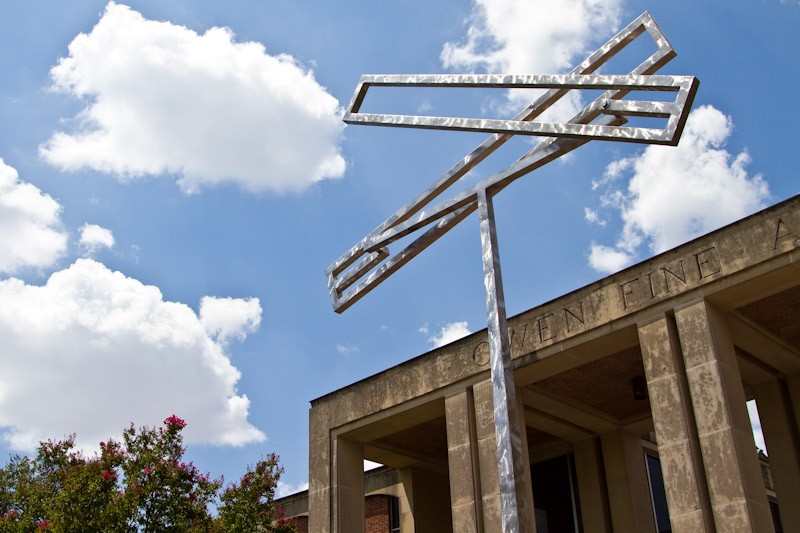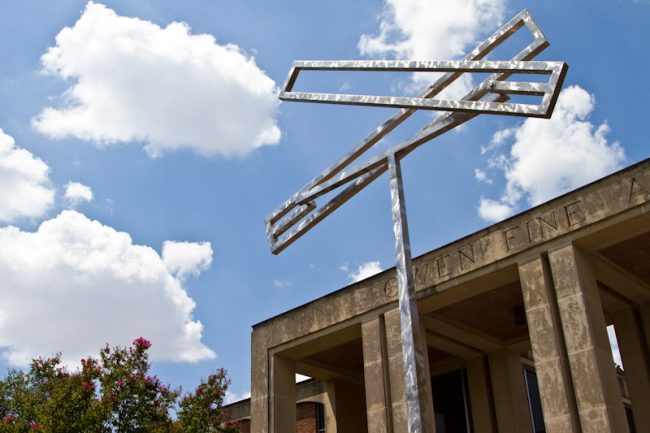
‘Two Open Rectangles Horizontal’ sits outside the Meadows School of the Arts reflecting both the artist’s vision and the effects of nature as they present themselves on the statue. (Michael Danser/The Daily Campus)
Artists take natural, beautiful structures in nature and shape them into sophisticated models and forms that appeal to the basic likes of human nature. This is precisely what George Rickey did with his sculpture that now sits on campus.
Outside of the Meadows School of the Arts stands a sculpture that fascinates passers-by. Planted among the solid oak trees lining the Boulevard, the sculpture has a granite base comparable to the rough and protective trunks of the surrounding trees and the dark bricks that lay across the plaza.
The steel rectangles on top of the sculpture imitate the square aluminum beams in the large windowpanes in the front of the Meadows School of the Arts.
Like the swaying of the branches and rustling of the leaves of the trees in the wind, the sculpture’s two horizontal rectangles rise and fall in spectacular arcs. Indeed, this sculpture, “Two Open Rectangles Horizontal” (1983-1984) includes four dimensions: length, width, height and time.
The slightest breeze can brush the steel rectangles into gentle movement. Conversely, the solid structure of the sculpture can withstand the strongest gusts of wind.
Light changes the sculpture as well. Early in the morning with the sunrise, the sculpture appears clear with heavy rays of the Texas sun showcasing the work to the rest of the campus. By sunset, the path of the sun has moved behind the Meadows School of the Arts.
Before the last beam of sunlight disappears, the steel rectangles light up in a dazzling display as the setting sun shines directly on the sculpture one final time. On some days, the sun is almost completely gone over the roof of Meadows, and its beams shine only into the tops of the trees along the Boulevard.
At such times, the graceful movement of the rectangles will suddenly rise up and catch the magnificent brilliance of the last rays of sunlight turning the rectangles into bars of solid and brilliant gold.
As quickly as they shine in the last bit of sunlight, the rectangles descend back into the shade and become dark and silvery.
Finally, around 8:30 p.m. with the sun set and the darkness of the night in its place, the spotlights at the base of the sculpture turn on and illuminate the sculpture into yet another version. The steel rectangles once reflecting the golden beams of the sun’s light now turn into shivery blocks of silver.
Resembling the moving branches in the wind during the day, the movement of the gleaming rectangles now evokes the paths of the cosmic bodies in the night sky.
The man behind this sculpture was the influential kinetic sculptor George Rickey (1907-2002). Although he was born in Indiana, he grew up in Scotland outside of Glasgow. He would study drawing and painting in Paris with noted artists like Fernand Léger, André Lhote and Amédée Ozenfant.
A true cosmopolitan, Rickey would take months at a time living in various parts of Europe during his young adulthood. At the outbreak of WWII, Rickey was in America and served in the Army Air Corps. Army tests showed his mechanical aptitude, ignored since adolescence, was strong; indeed his father was an engineer who studied at MIT.
Because of this, Rickey was assigned to troubleshoot the automatic computing instruments with which bomber gunners controlled their fire against enemy fighter planes.
This would be the first time Rickey would work professionally in a mechanical shop. Since he worked with projectiles, his job demanded he know in-depth the effects of wind and gravity on ballistics.
Taking a keen interest in his machine work, Rickey discovered his own artistic medium which he pioneered and is known for today. As early as the 1930’s, Rickey had seen some exhibits of the famous Alexander Calder (known for his mobile in appearance sculptures).
The juxtaposition of simple forms and elegant, sophisticated motion became his artistic practice. The 1950’s was a time of trial and error and finding his art form. By the 1960’s, Rickey’s style had matured and taken on its uniqueness that is known across the world.
The sculpture outside of the Owens Fine Arts building, “Two Open Rectangles Horizontal” is a special work because it represents the essence of Rickey’s artistic style. By the time of his artistic maturity, Ricky used mostly steel in all his sculptures (granite being the occasional exception).
His works take simple shapes like the steel rectangles and create gorgeous forms that move to the wind.
Before taking its place in front of the Meadows School of the Arts,
“Two Open Rectangles Horizontal” was standing at the One Arts AT&T Plaza in downtown Dallas.
Commissioned by AT&T Inc. in 1983, the sculpture is an excellent representation of Rickey’s work in the last decades of the 20th Century.
AT&T graciously donated the sculpture to the Meadows Museum to be part of the Meadows sculpture collection.
We are fortunate at SMU to have such sophisticated sculptures on a beautiful campus. It’s about time we take the time to get to know them.
Editor’s note:
Be on the lookout for more from Chris Calloway, as he guides Daily Campus readers through the artwork on campus in his series: In Situ.














